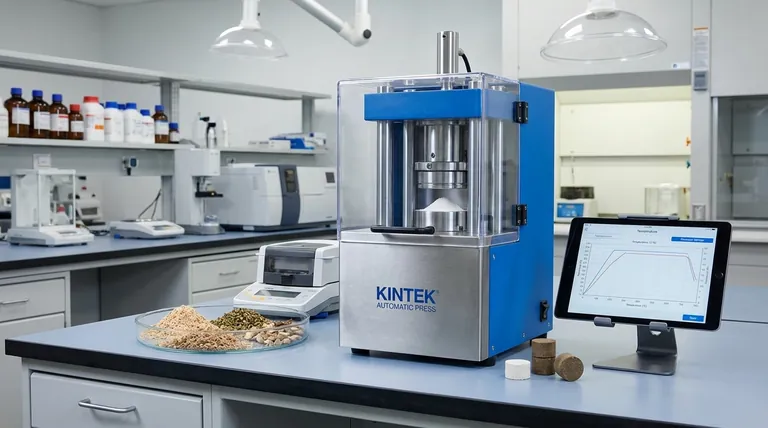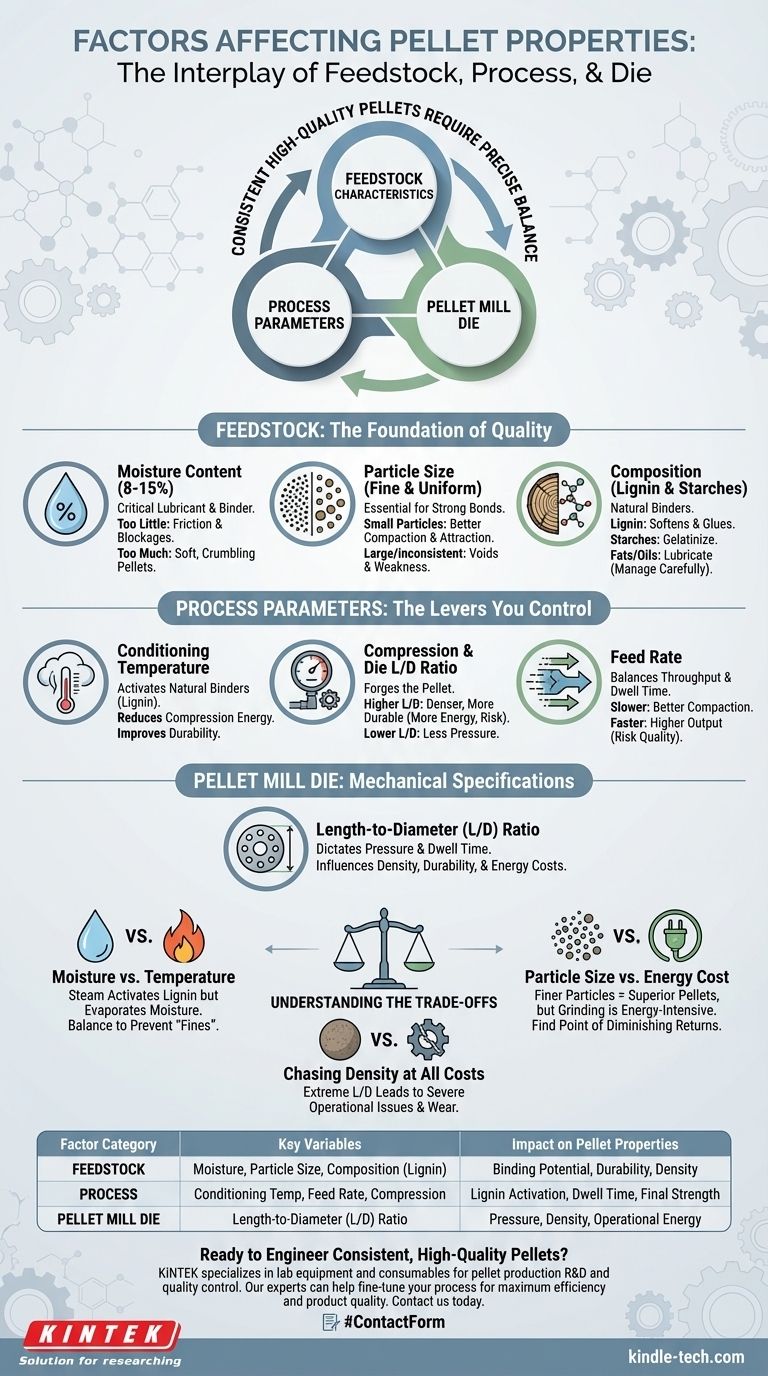In short, pellet properties are determined by three interconnected areas: the characteristics of the raw feedstock, the operational process parameters used during production, and the mechanical specifications of the pellet mill die. Mastering the interplay between these factors is the key to consistently producing high-quality pellets.
The fundamental challenge in pellet production is not about maximizing any single variable, but about achieving a precise balance. The raw material's moisture, particle size, and composition dictate the ideal temperature, pressure, and die configuration needed to create a durable, dense final product.

Feedstock Characteristics: The Foundation of Quality
The raw material you start with fundamentally defines the potential quality of your final pellets. No amount of process optimization can fully compensate for poor or inconsistent feedstock.
Moisture Content: The Critical Lubricant and Binder
Moisture acts as both a lubricant and a binding agent within the pellet die. The ideal range is typically between 8% and 15%.
Too little moisture increases friction, causing excessive die wear and potential blockages. Too much moisture prevents the particles from compacting properly, resulting in soft, low-durability pellets that easily crumble.
Particle Size: The Basis of Compaction
A small and uniform particle size is essential for creating strong bonds. Smaller particles have a greater surface area, allowing for better compaction and intermolecular attraction.
Large or inconsistent particles create voids and fracture points within the pellet structure. This leads to a weaker, less dense product with a lower durability rating.
Feedstock Composition: Natural Binders and Lubricants
The chemical makeup of the raw material is a primary driver of pellet quality. Lignin, a natural polymer found in woody biomass, softens under heat and pressure, acting as a natural glue to bind particles together.
Materials rich in starches also benefit from gelatinization, which enhances binding. Conversely, high concentrations of fats or oils can act as lubricants, which can sometimes reduce the friction needed for proper compaction if not managed correctly.
Process Parameters: The Levers You Control
Once your feedstock is prepared, the settings on your pellet mill become the primary levers for controlling the final product properties.
Conditioning Temperature: Activating Natural Binders
Conditioning involves pre-heating the feedstock, usually with steam, before it enters the die. This is arguably the most critical process step.
Proper heating softens the natural lignin, making it a much more effective binder. This process reduces the energy needed for compression and dramatically improves the final durability of the pellets.
Compression and Die Dimensions: Forging the Pellet
The physical design of the pellet die, specifically its length-to-diameter ratio (L/D), dictates the amount of pressure and dwell time the material experiences.
A higher L/D ratio means the material is compressed for a longer time in the die channel, typically resulting in a denser and more durable pellet. However, it also requires more energy and increases the risk of blockages.
Feed Rate: Balancing Throughput and Dwell Time
The speed at which feedstock is fed into the mill affects how long the material resides in the compression chamber.
A slower feed rate allows for longer dwell time, which can improve heat transfer and compaction. A faster rate increases output but can compromise pellet quality if the material doesn't have sufficient time under pressure to form strong bonds.
Understanding the Trade-offs
Optimizing pellet properties is a constant balancing act. Improving one metric can often negatively impact another, making it crucial to understand the inherent compromises.
The Moisture vs. Temperature Dilemma
Higher conditioning temperatures are excellent for activating lignin but also cause moisture to evaporate. If too much moisture is lost before compression, the feedstock becomes brittle and fails to bind, creating "fines" instead of pellets. This requires a precise balance of steam addition and temperature control.
The Particle Size vs. Energy Cost Equation
While finer particles produce superior pellets, the grinding process (size reduction) is extremely energy-intensive. There is a point of diminishing returns where the marginal improvement in pellet quality does not justify the significant increase in energy consumption and operational cost.
Chasing Density at All Costs
Using a very high L/D ratio die to maximize density can lead to severe operational issues. It drastically increases friction, leading to accelerated wear on the die and rollers, higher energy bills, and frequent plugging of the die channels, which halts production.
Optimizing Your Process for Specific Goals
Your ideal parameters will depend entirely on your primary objective, whether it's durability, production speed, or managing a difficult raw material.
- If your primary focus is maximum durability: Prioritize optimal moisture content (12-15%) and sufficient conditioning temperature to activate lignin, combined with a moderately high L/D ratio die.
- If your primary focus is high throughput: You may need to accept a slightly lower L/D ratio, but you must compensate by ensuring your particle size is exceptionally fine and uniform to maintain quality at higher speeds.
- If you are working with a difficult feedstock (e.g., low lignin): Pay meticulous attention to pre-conditioning and consider using a binding additive. Achieving a fine, consistent particle size is non-negotiable for these materials.
By systematically analyzing and controlling these interconnected factors, you can transition from simply making pellets to engineering them for consistent, high-quality results.
Summary Table:
| Factor Category | Key Variables | Impact on Pellet Properties |
|---|---|---|
| Feedstock Characteristics | Moisture Content, Particle Size, Composition (Lignin) | Determines binding potential, durability, and density. |
| Process Parameters | Conditioning Temperature, Feed Rate, Compression | Controls lignin activation, dwell time, and final pellet strength. |
| Pellet Mill Die | Length-to-Diameter (L/D) Ratio | Influences pressure, density, and operational energy costs. |
Ready to Engineer Consistent, High-Quality Pellets?
Optimizing the complex interplay between feedstock, process parameters, and your pellet mill die is the key to achieving superior pellet density and durability. KINTEK specializes in lab equipment and consumables for pellet production R&D and quality control. Our experts can help you select the right tools to analyze your feedstock and fine-tune your process for maximum efficiency and product quality.
Contact us today using the form below to discuss your specific pellet production challenges and how our solutions can help you achieve your goals.
Visual Guide

Related Products
- Automatic Laboratory Hydraulic Pellet Press Machine for Lab Use
- Laboratory Manual Hydraulic Pellet Press for Lab Use
- Laboratory Hydraulic Press Lab Pellet Press for Button Battery
- kbr pellet press 2t
- XRF & KBR plastic ring lab Powder Pellet Pressing Mold for FTIR
People Also Ask
- How much sample is needed for IR? Optimize Your Analysis with Minimal Material
- What is the ratio of KBr and sample in IR? Achieve Perfect Sample Concentration for Clear IR Spectra
- What is the use of KBr? Master Sample Prep for Accurate IR Spectroscopy
- How is a hydraulic press helpful for making KBr pellets? Achieve Superior FTIR Sample Preparation
- Why KBr is used for IR spectroscopy? The Ideal Medium for Solid Sample Analysis



















